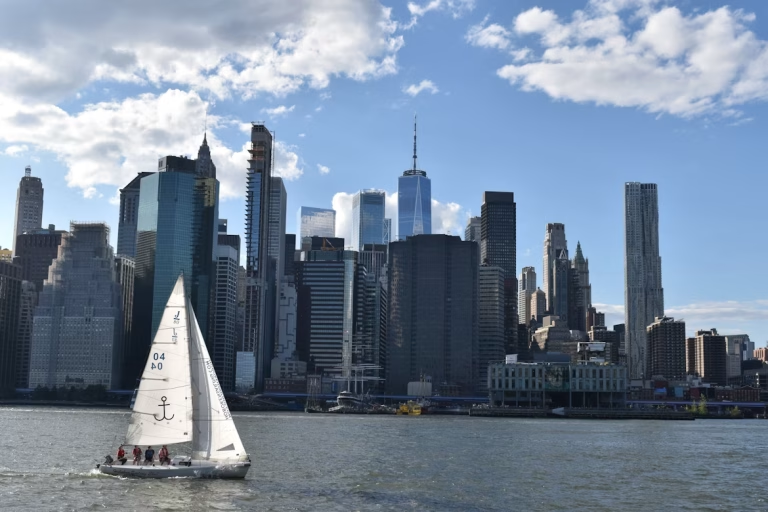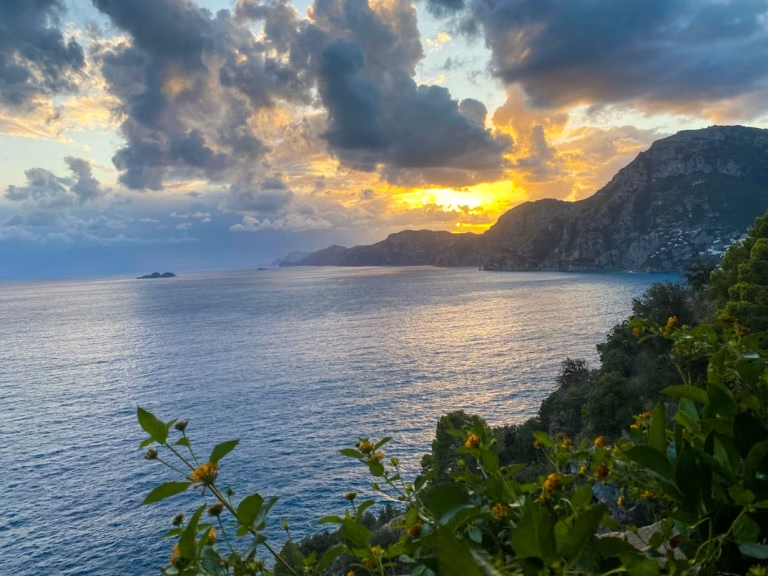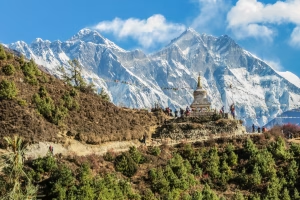
Bangladesh’s floating markets in Bangladesh represent one of the world’s most fascinating commercial traditions, where centuries-old boat trading continues thriving across the country’s extensive river networks. These extraordinary waterborne marketplaces offer visitors authentic glimpses into traditional commerce that flows as naturally as the delta’s countless waterways. From the bustling morning energy of Barisal’s main floating market to the specialized guava trading boats of Jhalokati, the floating markets in Bangladesh combine economic necessity with cultural celebration, creating unmissable destinations for travelers seeking genuine experiences.
The magic of floating markets in Bangladesh lies not just in their commercial function, but in their role as living cultural museums where traditional lifestyles persist unchanged for generations. Every dawn brings renewed activity as wooden boats laden with fresh produce, handcrafted goods, and regional specialties converge along predetermined waterways, transforming ordinary rivers into vibrant trading hubs that pulse with the rhythm of rural Bangladesh.
Understanding the Cultural Phenomenon of Floating Markets in Bangladesh

The floating markets in Bangladesh emerged from geographical necessity rather than commercial convenience. With over 700 rivers flowing through the country, creating an intricate network of waterways that divide communities, boat-based commerce became essential for connecting producers with consumers across water barriers. This practical origin evolved into a rich cultural tradition that now defines rural Bangladeshi identity.
The historical development of floating markets in Bangladesh reflects the country’s adaptation to its unique delta geography. The Ganges-Brahmaputra-Meghna river system creates seasonal flooding patterns that traditionally made land-based transportation challenging. Communities developed sophisticated boat-building techniques and navigation skills, establishing regular trading schedules that synchronized with tidal patterns and seasonal agricultural cycles.
Modern floating markets in Bangladesh maintain these traditional rhythms while adapting to contemporary economic pressures. Digital communication now helps coordinate market schedules, but the fundamental trading methods remain unchanged. Vendors still rely on visual inspection, personal relationships, and time-honored bargaining techniques that their ancestors perfected over centuries.
The social significance of floating markets in Bangladesh extends beyond mere commerce. These markets serve as community gathering points where news spreads, relationships develop, and cultural traditions transfer between generations. Young vendors learn traditional boat handling, product knowledge, and negotiation skills by working alongside family members, ensuring cultural continuity.
Environmental sustainability characterizes floating markets in Bangladesh, as boat-based transport produces minimal carbon emissions compared to truck-based distribution systems. The markets also support biodiversity by encouraging small-scale, diversified agriculture that maintains local crop varieties and traditional farming methods.
Comprehensive Guide to Top 10 Floating Markets in Bangladesh
1. Barisal Floating Market
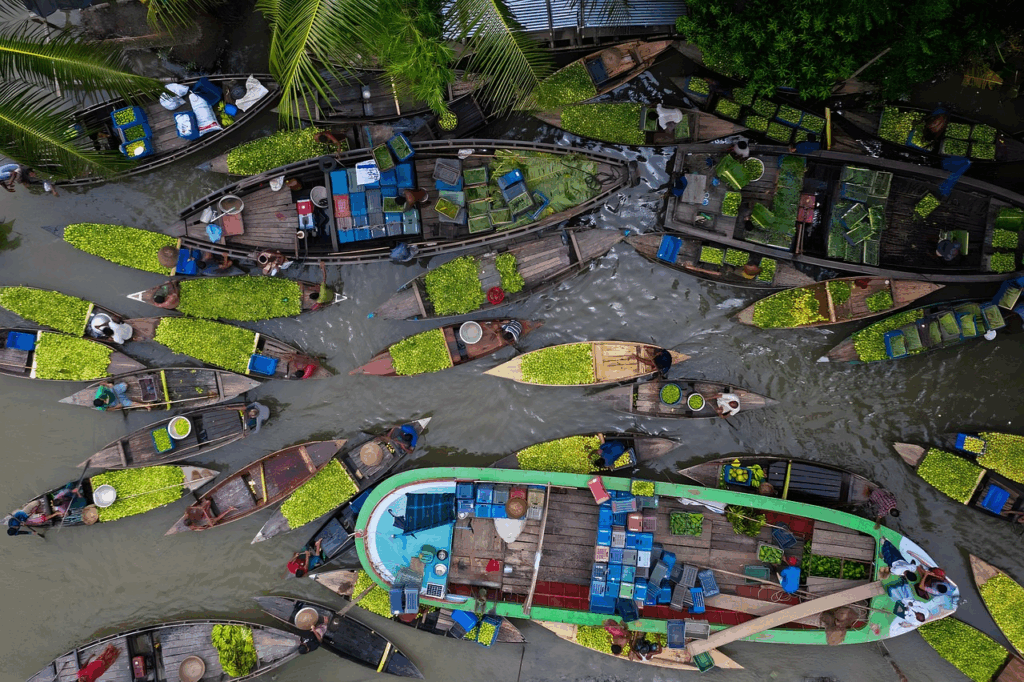
The undisputed champion among floating markets in Bangladesh, Barisal’s main market operates along the Kirtankhola River with spectacular early morning displays of traditional commerce. This massive marketplace brings together hundreds of wooden boats from surrounding villages, creating one of South Asia’s most photographed commercial scenes.
The market’s operations begin before sunrise when vendors navigate their loaded boats through narrow canals toward the main convergence point. By first light, the river transforms into a floating bazaar where fresh vegetables, tropical fruits, aromatic spices, handwoven textiles, and traditional crafts create a sensory feast for visitors.
Cultural authenticity defines the Barisal experience within floating markets in Bangladesh. Vendors maintain traditional dress, speak in regional dialects, and employ bargaining techniques passed down through families. The wooden boats themselves represent masterpieces of local craftsmanship, built using techniques refined over generations to navigate shallow waters efficiently.
Tourist infrastructure around Barisal floating market includes guided boat tours, photography packages, and cultural interpretation services. Professional guides explain trading customs, identify unique products, and facilitate respectful interactions between visitors and vendors. The market’s accessibility via multiple transportation options makes it the most visited among floating markets in Bangladesh.
2. Floating Guava Market, Jhalokati District

The specialized floating guava market in Vimruli village represents one of Asia’s largest fruit-specific trading centers, showcasing how floating markets in Bangladesh adapted to serve particular agricultural niches. This remarkable 200-year-old market operates exclusively during guava season, attracting wholesalers from across the subcontinent.
The market’s unique specialization allows visitors to observe intensive fruit trading where quality assessment, pricing negotiations, and bulk transactions demonstrate sophisticated commercial systems. Dozens of guava varieties arrive on boats from surrounding orchards, each with distinct characteristics, flavors, and market values that experienced traders assess through sight, touch, and taste.
Cultural significance permeates every aspect of the guava market within floating markets in Bangladesh. Local festivals celebrate the guava harvest, boat races mark seasonal openings, and traditional songs accompany trading activities. The market strengthens community bonds while preserving agricultural knowledge about cultivation techniques, variety selection, and post-harvest handling.
Environmental benefits distinguish this market among floating markets in Bangladesh, as boat transport reduces fruit damage compared to road transport over rough terrain. The direct producer-to-buyer connections ensure fresher products while supporting sustainable farming practices that maintain soil health and biodiversity.
3. Floating Vegetable Market, Barisal Region
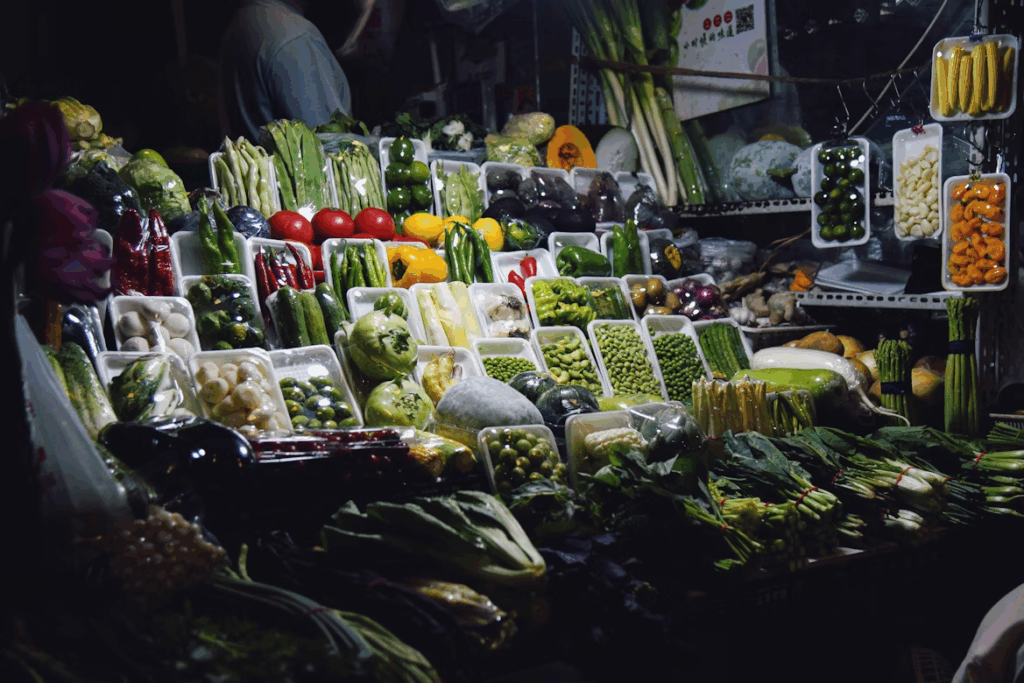
Multiple vegetable-focused markets operate throughout the Barisal region on rotating weekly schedules, ensuring consistent fresh produce availability across water-divided communities. These markets represent the backbone of floating markets in Bangladesh, providing essential food distribution services while maintaining traditional trading relationships.
Each day brings different market locations with specialized focuses: Monday markets might emphasize leafy greens, while Thursday markets feature root vegetables and rice varieties. This systematic rotation ensures balanced nutrition availability while allowing vendors to develop expertise in specific product categories.
The markets demonstrate remarkable organizational efficiency despite appearing chaotic to casual observers. Vendors arrive at precise times, occupy traditional positions based on family relationships and product types, and follow unwritten protocols for boat positioning and customer access. These self-regulating systems showcase the sophisticated social structures underlying floating markets in Bangladesh.
Agricultural diversity shines through these markets where heirloom varieties and traditional crops maintain market presence alongside modern hybrids. Visitors observe how floating markets in Bangladesh preserve genetic diversity by supporting small-scale farmers who maintain traditional seed varieties and cultivation methods.
4. Rice Floating Market, Barisal Region

Rice trading represents the foundation of floating markets in Bangladesh, given the grain’s central importance in Bangladeshi cuisine and culture. These specialized markets operate during harvest seasons when farmers transport paddy and processed rice to buyers via traditional wooden boats designed specifically for grain transport.
The markets showcase incredible rice variety – from aromatic Basmati-type varieties to glutinous rice used in traditional sweets. Experienced traders assess rice quality through visual inspection, aroma evaluation, and texture testing, demonstrating expertise developed through generations of family involvement in floating markets in Bangladesh.
Quality control mechanisms within rice floating markets reflect sophisticated understanding of grain storage, moisture content, and pest management. Vendors employ traditional methods for maintaining rice quality during water transport, including specialized boat designs with proper ventilation and moisture protection.
Economic impact extends beyond immediate transactions as rice floating markets connect rural producers with urban consumers, supporting food security while maintaining competitive pricing through direct trade relationships that eliminate multiple intermediary margins.
5. Timber Floating Market Network
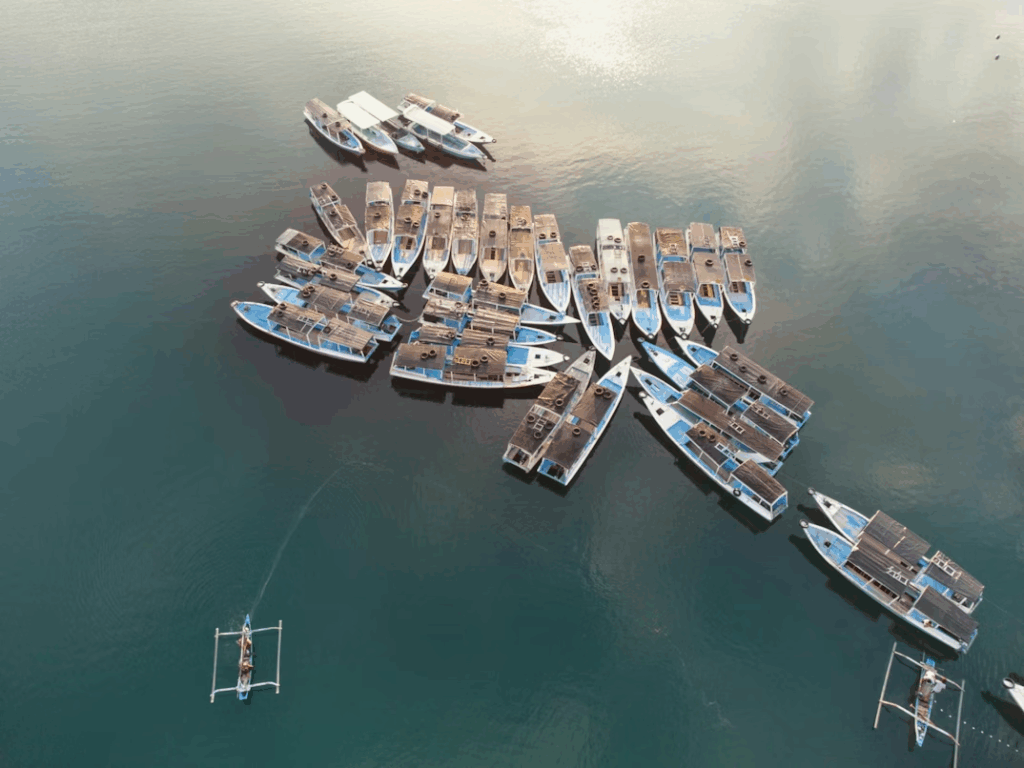
The timber floating markets distribute wood products throughout southern Bangladesh, utilizing waterways perfectly suited for transporting heavy materials. These markets demonstrate how floating markets in Bangladesh adapted to serve specialized industries while maintaining traditional trading methods and community relationships.
Different timber markets specialize in various wood products: construction lumber, boat-building materials, furniture wood, and bamboo products. Each market develops expertise in specific timber types, quality assessment, and pricing based on intended uses and regional preferences.
Traditional boat modifications for timber transport showcase remarkable engineering ingenuity within floating markets in Bangladesh. Specially designed vessels feature reinforced hulls, modified loading systems, and enhanced stability features necessary for safely transporting heavy wood cargo through narrow waterways.
Environmental considerations increasingly influence timber floating markets as sustainable forestry practices gain recognition. Markets now emphasize responsibly sourced materials, traditional timber species, and renewable bamboo products that support ecological balance while meeting construction needs.
6. Floating Fish Market Network
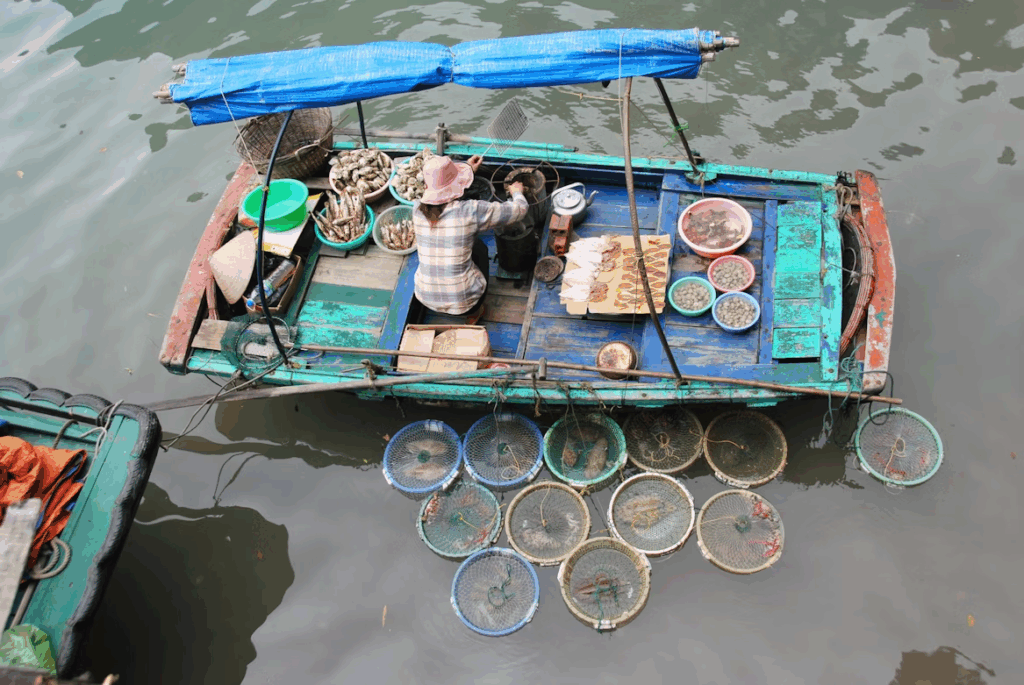
Fresh fish and seafood markets operate across multiple waterways, reflecting Bangladesh’s position as one of the world’s leading fish-producing nations. These markets showcase the incredible diversity of aquatic life thriving in the country’s rivers, ponds, and coastal waters while demonstrating traditional fishing and trading methods.
The floating fish markets in Bangladesh operate with precise timing coordinated with fishing schedules and tidal patterns. Fishermen arrive with overnight catches, ice boats provide preservation services, and buyers assess quality using traditional techniques for evaluating freshness, size, and species characteristics.
Seasonal variations create dynamic market experiences as different fish species become available throughout the year. Monsoon seasons bring river fish varieties, while dry seasons favor pond fish and coastal species. This natural rhythm showcases how floating markets in Bangladesh remain synchronized with ecological cycles.
Traditional preservation and processing methods demonstrate sophisticated knowledge of food safety and quality maintenance without refrigeration. Salt-curing, smoking, and drying techniques preserve fish for extended periods while maintaining nutritional value and developing unique flavors appreciated in regional cuisine.
7. Kuakata Backwater Markets

The serene floating markets in Kuakata offer peaceful alternatives to the bustling energy of Barisal’s main markets. These backwater markets operate in tranquil settings where traditional commerce unfolds at gentler paces, making them ideal for visitors seeking authentic experiences without overwhelming sensory overload.
Scenic beauty distinguishes Kuakata’s floating markets in Bangladesh from their busier counterparts. Palm-lined waterways, traditional fishing boats, and coastal landscapes create picture-perfect settings where commerce blends seamlessly with natural splendor. The markets attract photographers and cultural enthusiasts seeking quintessential rural Bangladesh experiences.
Product diversity reflects the coastal location’s unique position between river and sea systems. Fresh seafood arrives from Bay of Bengal fishing expeditions, while agricultural products come from inland farming communities. This convergence creates markets where marine and terrestrial products mix, offering visitors comprehensive samples of regional production.
Community-centered trading relationships characterize these markets within floating markets in Bangladesh. Vendors and buyers often maintain multi-generational business relationships based on trust, quality consistency, and mutual support during difficult seasons. These personal connections create market atmospheres that feel more like family gatherings than commercial transactions.
8. Floating Fruit Markets, Southern Region
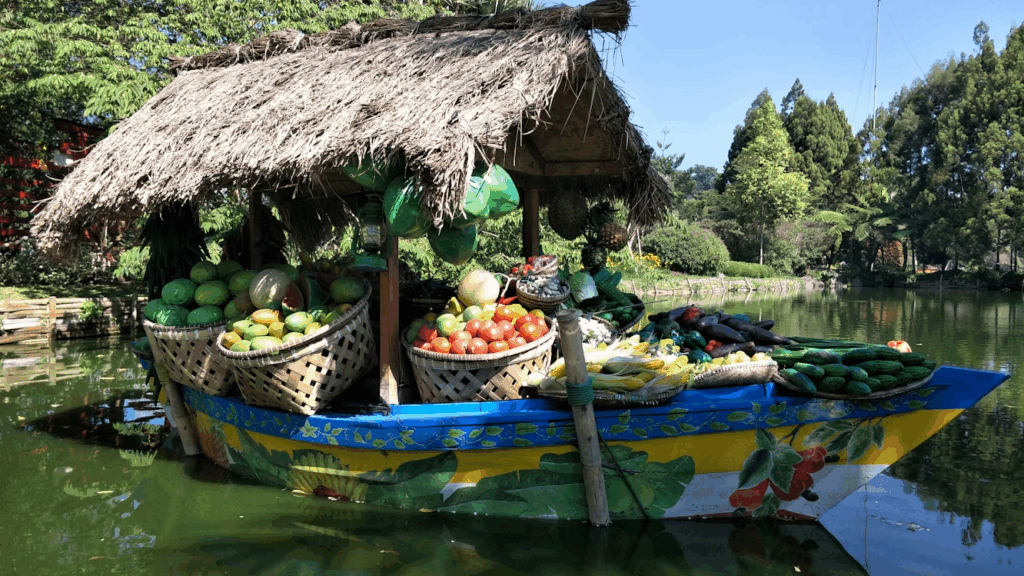
Seasonal fruit markets throughout southern Bangladesh showcase the region’s remarkable agricultural diversity beyond the famous guava specialization. These rotating markets highlight how floating markets in Bangladesh adapted to serve specific agricultural cycles while maintaining year-round commercial activity.
Mango seasons bring spectacular displays when boats overflow with different varieties ranging from small sweet types to large commercial grades. Banana markets feature everything from cooking varieties to dessert types, while jackfruit seasons create impressive scenes of massive fruits being carefully transported and traded.
Quality assessment techniques within fruit floating markets demonstrate sophisticated agricultural knowledge. Vendors evaluate ripeness, sugar content, storage potential, and transport durability using traditional methods refined through generations of fruit trading experience in floating markets in Bangladesh.
Regional specializations emerge based on local growing conditions and traditional cultivation expertise. Certain areas excel in specific fruit varieties due to soil conditions, water availability, and accumulated knowledge about cultivation techniques that families guard and transfer through generations.
9. Floating Handicrafts Markets
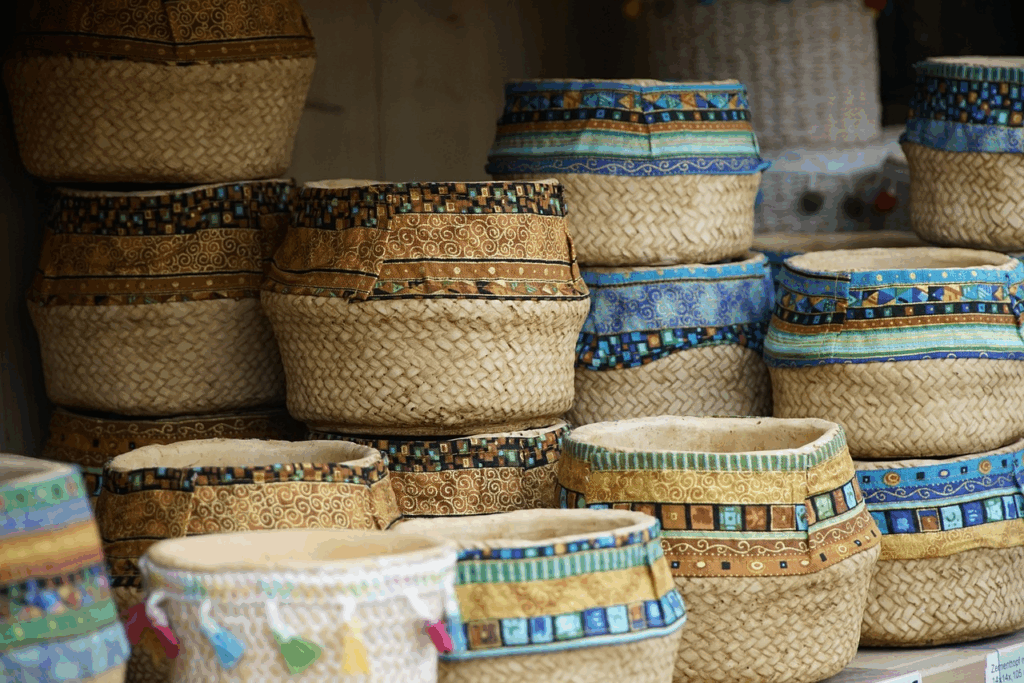
Artisan boats showcase traditional Bangladeshi handicrafts, preserving cultural arts while providing sustainable income for craftspeople. These specialized floating markets in Bangladesh support traditional skills that might otherwise disappear in increasingly modernized retail environments.
Traditional handicrafts featured in these markets include handwoven textiles using traditional patterns, carved wooden items reflecting regional artistic styles, pottery made with local clay, and metalwork demonstrating centuries-old techniques. Each craft represents specific regional traditions and family specializations passed through generations.
The markets provide direct connections between artisans and customers, eliminating retail markups while allowing craftspeople to explain their techniques and cultural significance. Visitors gain deeper appreciation for traditional arts while ensuring their purchases directly support artisan families rather than commercial intermediaries.
Quality and authenticity distinguish handicraft floating markets in Bangladesh from mass-produced alternatives available in urban retail stores. Artisans take pride in maintaining traditional standards while adapting designs to contemporary tastes without compromising cultural integrity.
10. Floating Flower Markets, Barisal Waterways

Seasonal flower markets create spectacular visual displays while serving important cultural and religious functions within floating markets in Bangladesh. These colorful markets supply flowers for temples, wedding ceremonies, festival celebrations, and other cultural events that require traditional floral arrangements.
The markets operate on schedules coordinated with religious calendars and cultural celebrations. Major festivals like Durga Puja, Kali Puja, and wedding seasons create peak demand periods when flower boats converge in impressive displays that transform waterways into floating gardens.
Traditional flower varieties grown specifically for religious and cultural purposes maintain their presence in these markets despite commercial pressure toward more profitable ornamental varieties. This preservation aspect makes flower floating markets in Bangladesh important for maintaining botanical diversity and traditional horticultural knowledge.
Seasonal coordination requires sophisticated planning as flower cultivation cycles must align with cultural celebration schedules. Growers plan planting times to ensure peak blooms coincide with major festivals, demonstrating the complex agricultural planning that supports floating markets in Bangladesh.
Deep Dive: Traditional Trading Methods in Floating Markets in Bangladesh

The trading methods employed in floating markets in Bangladesh represent sophisticated commercial systems developed over centuries to function efficiently in challenging water-based environments. These systems demonstrate remarkable adaptation to environmental constraints while maintaining fairness and community harmony.
Boat positioning follows traditional protocols based on product types, family relationships, and arrival times. Early arriving vendors secure prime positions along main waterways, while specialty products often cluster in designated areas that facilitate comparison shopping and competitive pricing.
Quality assessment techniques vary by product category but consistently rely on sensory evaluation methods perfected through generations of experience. Fruit vendors assess ripeness through color, firmness, and aroma, while textile traders evaluate fiber quality, weaving tightness, and color fastness using traditional testing methods.
Price negotiation in floating markets in Bangladesh follows cultural protocols that balance fair pricing with relationship maintenance. Successful vendors develop reputations for honest dealing and consistent quality, leading to repeat customer relationships that provide economic stability across seasonal variations.
Payment systems remain predominantly cash-based, though some vendors now accept mobile banking for larger transactions. Traditional credit arrangements between trusted trading partners continue supporting seasonal cash flow needs, particularly during agricultural off-seasons when inventory investment requires advance funding.
Economic Impact and Sustainable Tourism in Floating Markets in Bangladesh
The economic significance of floating markets in Bangladesh extends far beyond immediate commercial transactions, supporting rural development while preserving traditional livelihoods. These markets provide essential income opportunities for communities with limited access to urban employment while maintaining cultural identity and traditional skills.
Direct trade relationships eliminate intermediary costs, ensuring farmers and artisans receive fair prices for their products while keeping consumer costs reasonable. This economic efficiency supports rural poverty reduction while encouraging continued agricultural production and traditional craft maintenance.
Tourism revenue increasingly supplements traditional commerce in floating markets in Bangladesh, providing additional income streams for vendors, boat operators, tour guides, and hospitality services. This economic diversification helps communities maintain traditional lifestyles while adapting to modern economic opportunities.
Sustainable tourism practices ensure that visitor interest in floating markets in Bangladesh benefits local communities without disrupting traditional operations. Responsible tour operators coordinate visit schedules to minimize market interference while maximizing cultural exchange opportunities for both visitors and vendors.
Infrastructure development around major floating markets supports both traditional commerce and tourism activities. Improved boat launches, visitor facilities, and transportation connections enhance accessibility while maintaining the authentic character that makes floating markets in Bangladesh internationally distinctive.
Seasonal Variations and Market Dynamics
The operational patterns of floating markets in Bangladesh follow complex seasonal rhythms determined by agricultural cycles, weather patterns, and cultural calendars. Understanding these variations helps visitors plan optimal experiences while appreciating the sophisticated coordination required for water-based commerce.
Dry season markets (October through March) operate at full capacity with comfortable weather conditions and maximum boat accessibility. High water levels during monsoon seasons affect market locations and schedules, though trading continues with adaptations to changing water conditions.
Agricultural seasons create dramatic variations in product availability and market energy. Harvest periods bring peak activity when farmers rush to market fresh crops, while planting seasons see reduced activity as communities focus on agricultural preparation rather than commerce.
Festival seasons significantly impact floating markets in Bangladesh as demand increases for specific products required for celebrations. Flower markets expand during religious festivals, handicraft markets emphasize ceremonial items, and food markets feature special ingredients for traditional feast preparations.
Weather dependency requires flexible planning for both vendors and visitors to floating markets in Bangladesh. Market schedules adapt to storm predictions, extreme temperatures, and water level fluctuations, demonstrating the resilience and adaptability that characterizes traditional water-based commerce.
Cultural Etiquette and Visitor Guidelines for Floating Markets in Bangladesh
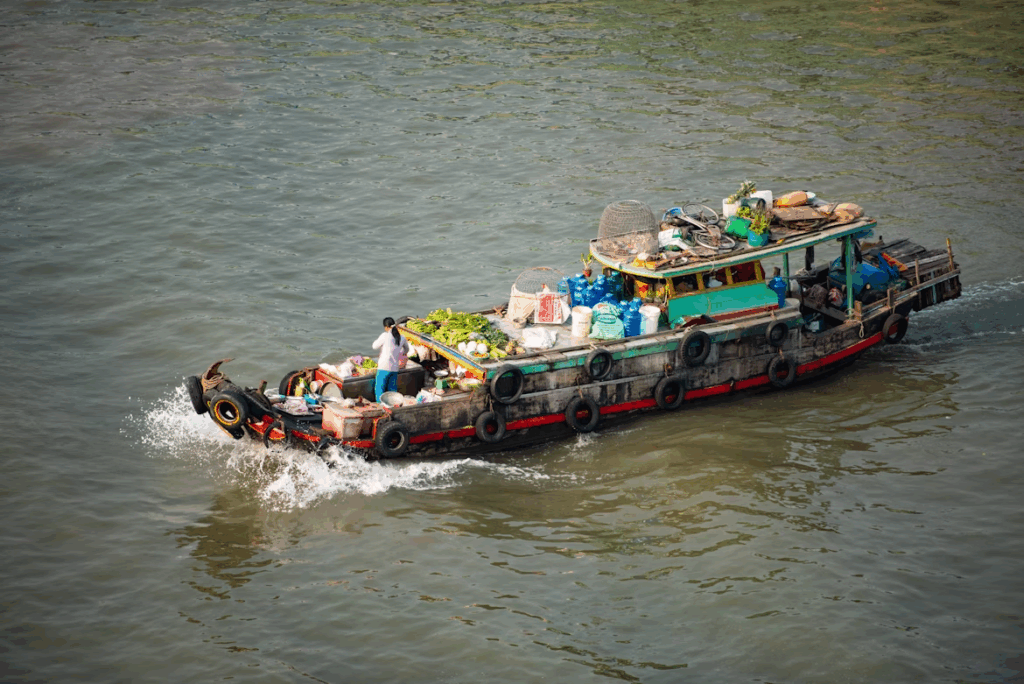
Respectful engagement with floating markets in Bangladesh requires understanding traditional customs and social protocols that govern interactions between vendors and customers. These guidelines ensure positive experiences while supporting cultural preservation and community harmony.
Photography etiquette involves requesting permission before photographing vendors or their products, particularly when focusing on individuals rather than general market scenes. Many vendors welcome photography that showcases their products and traditional lifestyle, but appreciate respectful requests that acknowledge their dignity and privacy.
Bargaining represents expected social interaction in floating markets in Bangladesh, but should remain friendly and respectful rather than aggressive or dismissive. Successful bargaining involves understanding reasonable price ranges, appreciating product quality, and maintaining relationships that encourage future positive interactions.
Dress codes should respect local customs with modest clothing appropriate for rural, traditional communities. Comfortable footwear suitable for boat boarding and potentially wet conditions ensures safety while showing respect for market environments.
Language considerations enhance interactions in floating markets in Bangladesh. Learning basic Bengali greetings and numbers facilitates communication while demonstrating cultural interest that vendors appreciate. Many vendors speak limited English, making gesture-based communication and patience important for successful exchanges.
Traditional Boat Construction and Navigation in Floating Markets in Bangladesh
The boats serving floating markets in Bangladesh represent remarkable examples of traditional maritime engineering, designed specifically for shallow water navigation and efficient cargo transport. These vessels demonstrate centuries of refinement in naval architecture adapted to local conditions and commercial needs.
Traditional boat designs vary by region and intended use within floating markets in Bangladesh. Narrow, shallow-draft vessels navigate restricted waterways, while broader boats provide stability for heavy cargo transport. Each design reflects local knowledge about water conditions, cargo requirements, and navigation challenges specific to different market locations.
Construction techniques employ traditional materials and methods that create durable, repairable vessels suitable for daily commercial use. Local craftsmen build boats using indigenous hardwoods, traditional joinery methods, and waterproofing techniques that ensure longevity in challenging aquatic environments.
Navigation skills required for operating in floating markets in Bangladesh include understanding tidal patterns, current directions, shallow water hazards, and traffic coordination among numerous boats in confined spaces. Experienced boatmen develop intuitive knowledge of water conditions that enables safe, efficient movement through crowded market areas.
Maintenance traditions ensure boat longevity through regular repairs, seasonal overhauls, and preventive care that keeps vessels operational year-round. These skills represent important traditional knowledge that supports the continued viability of floating markets in Bangladesh.
Economic Significance and Rural Development Impact
The floating markets in Bangladesh play crucial roles in rural economic development by providing market access for small-scale producers who might otherwise struggle to reach urban consumers. These markets support agricultural diversity, rural employment, and traditional skill maintenance while contributing to food security and cultural preservation.
Income generation through floating markets in Bangladesh supports thousands of rural families involved in production, transport, and trading activities. The markets provide economic opportunities for people with limited capital investment capacity, as boat-based trading requires minimal infrastructure compared to land-based retail operations.
Agricultural support systems within floating markets in Bangladesh encourage crop diversification and traditional variety maintenance. Markets provide reliable outlets for heirloom varieties and specialty products that might not survive in mass commercial agriculture, supporting biodiversity preservation alongside economic development.
Women’s participation in floating markets in Bangladesh varies by region and cultural practice, but increasingly includes roles in product preparation, quality control, and financial management. Some markets feature female vendors specializing in particular products like handwoven textiles or traditional food preparations.
Supply chain efficiency improves through direct producer-consumer connections that floating markets in Bangladesh facilitate. Reduced transportation costs, elimination of intermediary markups, and improved product freshness benefit both producers and consumers while maintaining competitive market pricing.
Tourism Development and Cultural Exchange

International recognition of floating markets in Bangladesh continues growing as travel bloggers, photographers, and cultural enthusiasts share experiences through digital media platforms. This attention brings tourism revenue while raising awareness about traditional lifestyles and environmental conservation needs.
Responsible tourism initiatives ensure that visitor interest in floating markets in Bangladesh benefits local communities without disrupting traditional operations or overwhelming rural infrastructure. Sustainable tourism practices include visitor number limits, respectful behavior guidelines, and economic benefit distribution systems.
Cultural exchange opportunities through floating markets in Bangladesh provide mutual learning experiences where visitors gain insights into traditional lifestyles while vendors learn about different cultures and global perspectives. These interactions often lead to lasting friendships and continued cultural connections.
Educational programs developed around floating markets in Bangladesh serve both domestic and international audiences interested in traditional commerce, sustainable agriculture, and cultural preservation. Universities, cultural organizations, and development agencies study these markets as examples of successful traditional economic systems.
Photography tours and cultural immersion programs provide structured ways for visitors to engage with floating markets in Bangladesh while ensuring appropriate compensation for vendors and communities that accommodate tourist interest in their traditional lifestyles.
Environmental Sustainability and Conservation
The floating markets in Bangladesh demonstrate environmentally sustainable commerce through minimal carbon emissions, reduced packaging waste, and support for traditional agriculture that maintains soil health and biodiversity. These markets offer models for sustainable development that balances economic needs with environmental protection.
Water quality considerations affect floating markets in Bangladesh as pollution from urban areas and industrial activities threatens the river systems that support market operations. Conservation efforts focus on maintaining clean waterways essential for market continuation and public health protection.
Traditional agricultural methods supported by floating markets in Bangladesh employ minimal chemical inputs while maintaining soil fertility through crop rotation, organic fertilization, and integrated farming systems that include fish cultivation in rice fields and mixed cropping techniques.
Waste management in floating markets in Bangladesh relies on traditional practices that minimize environmental impact. Organic waste becomes compost or fish feed, while minimal packaging reduces plastic pollution in waterway systems that support market operations.
Climate change adaptation strategies help floating markets in Bangladesh adjust to changing rainfall patterns, increased storm frequency, and shifting agricultural seasons. Markets demonstrate resilience through flexible scheduling, diversified product offerings, and adaptive infrastructure that responds to changing environmental conditions.
Planning Your Floating Markets in Bangladesh Adventure
Optimal Timing and Seasonal Considerations
The best period for experiencing floating markets in Bangladesh spans October through March when weather conditions remain comfortable and market operations function at full capacity. This dry season provides ideal conditions for boat travel, photography, and extended market exploration without weather-related complications.
Early morning visits (4:30-8:00 AM) capture peak market activity when vendors converge and trading energy reaches maximum intensity. Later morning visits offer different perspectives as markets disperse and vendors return to their home communities, providing insights into the complete market cycle.
Seasonal market variations create different experiences throughout the year in floating markets in Bangladesh. Harvest seasons bring abundance and variety, while off-seasons showcase how communities maintain commerce during agricultural slow periods through stored goods, preserved products, and alternative income sources.
Transportation and Access Planning
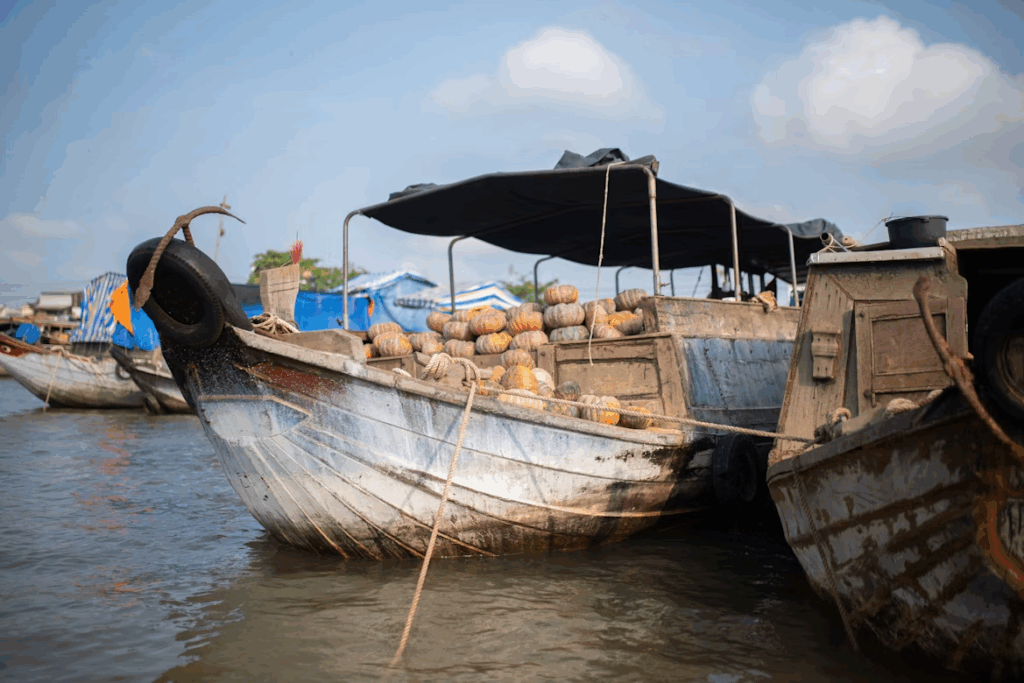
Reaching floating markets in Bangladesh typically requires combination transportation involving buses, boats, and local guides who understand market schedules and access points. Planning should account for travel time to rural locations and coordination with market operating hours for optimal experiences.
Professional tour operators provide comprehensive packages that handle transportation logistics, boat arrangements, cultural interpretation, and safety considerations for floating markets in Bangladesh visits. These services ensure smooth experiences while supporting local tourism infrastructure development.
Independent travel to floating markets in Bangladesh requires advance research about market schedules, transportation connections, and local accommodation options. Rural locations may have limited facilities, making preparation essential for comfortable and successful visits.
Cultural Preparation and Expectations
Understanding cultural contexts enhances appreciation of floating markets in Bangladesh beyond surface-level tourist experiences. Background reading about rural Bangladeshi lifestyles, traditional agriculture, and river-based communities provides frameworks for meaningful cultural engagement during market visits.
Language preparation involves learning basic Bengali phrases for greetings, numbers, and common market terms that facilitate better communication with vendors and demonstrate cultural respect. While many vendors speak limited English, effort to communicate in Bengali receives warm appreciation.
Expectation management helps visitors appreciate floating markets in Bangladesh authentically rather than seeking commercialized tourist experiences. These markets primarily serve local communities, so visitors should expect genuine working environments rather than staged tourist attractions.
Photography and Cultural Documentation
The visual appeal of floating markets in Bangladesh attracts photographers from around the world seeking authentic cultural documentation and stunning scenic compositions. These markets provide extraordinary opportunities for capturing traditional lifestyles against spectacular natural backdrops.
Technical photography considerations include early morning lighting conditions, boat stability challenges, and respectful distance maintenance while capturing candid market interactions. Professional photographers recommend waterproof equipment protection and backup power supplies for extended shooting sessions.
Cultural sensitivity in photography ensures that documentation of floating markets in Bangladesh respects vendor dignity and community privacy. Collaborative approaches that involve vendors in photography decisions often result in better images while building positive relationships and cultural understanding.
Conclusion: Embracing Bangladesh’s Floating Market Heritage
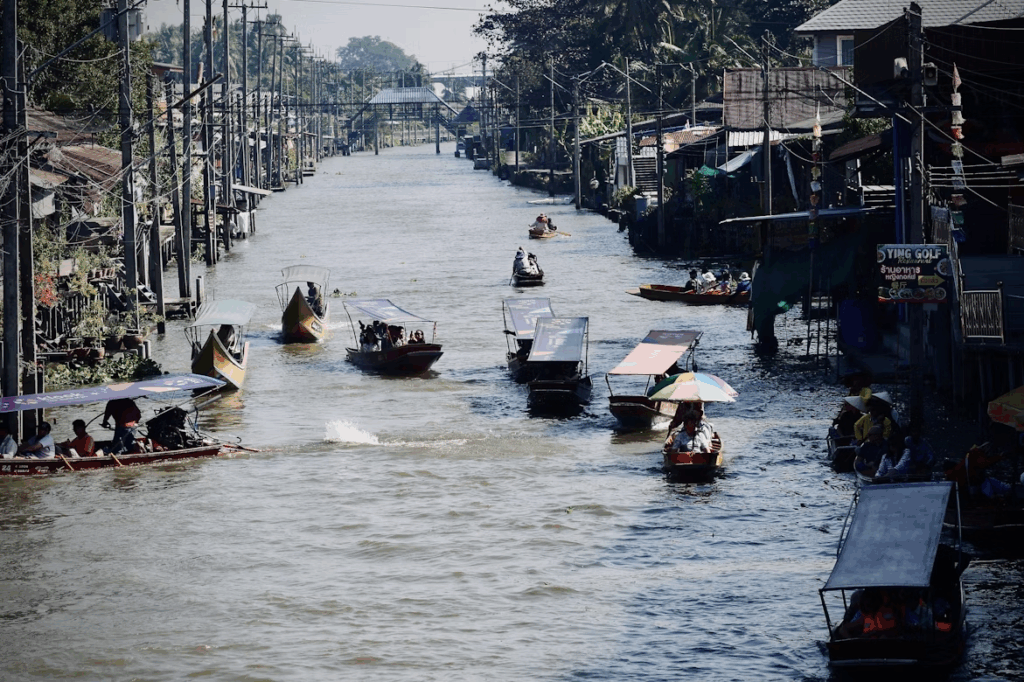
Floating markets in Bangladesh represent irreplaceable cultural treasures where centuries-old traditions continue thriving in modern times. These remarkable waterborne marketplaces provide unparalleled opportunities to experience authentic Bangladeshi culture while supporting local communities through responsible tourism and direct commerce.
Whether drawn to the bustling energy of Barisal’s main market, the specialized charm of guava trading boats, the serene beauty of backwater markets, or the diverse offerings across the complete network of floating markets in Bangladesh, each destination delivers unique insights into the country’s riverine heritage and traditional commerce systems. For a detailed overview of the Floating Guava Market and its cultural significance, see ToursnTripsBD here.
The continued vitality of floating markets in Bangladesh demonstrates how traditional economic systems can adapt to modern challenges while preserving cultural identity and community relationships. Tour Packages and Information on Barisal & Backwaters Floating Market provide practical travel advice for visitors planning to explore these unique waterways here. For travelers seeking authentic cultural experiences that go beyond conventional tourism, these markets provide immersive encounters with living traditions that have sustained communities for generations.
Planning visits to floating markets in Bangladesh during optimal seasons, respecting local customs, and engaging meaningfully with vendors and communities ensures memorable experiences that benefit both visitors and local populations. These markets remind us that commerce can be beautiful, sustainable, and culturally enriching when rooted in traditional wisdom and community values.
For travelers interested in similar authentic cultural experiences, exploring photogenic fishing villages offers comparable traditional lifestyle encounters, while budget-friendly warm destinations provide additional opportunities for meaningful cultural tourism across South Asia.


